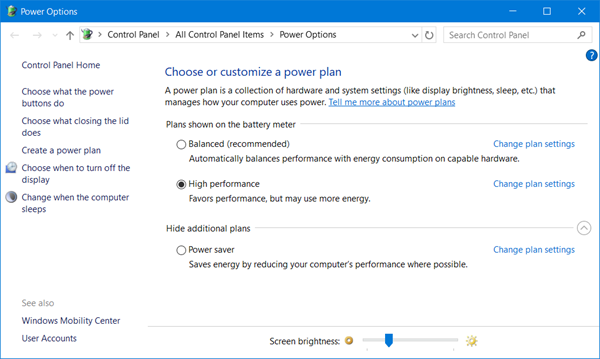

- #Windows 7 brightness slider missing install
- #Windows 7 brightness slider missing driver
- #Windows 7 brightness slider missing archive
- #Windows 7 brightness slider missing windows 10
- #Windows 7 brightness slider missing software
Download F.lux to your device and install it here. The program can adjust your screen brightness easier to see at night. f.lux is a program that automatically adjusts colors based on the time of day and lighting in your room. Use f.lux to adjust Monitor (for both Laptop and computer) Step 10: After your computer has restarted, click on Power Options in the system tray to find the restored Brightness Slider slider to adjust the screen brightness.ģ.
#Windows 7 brightness slider missing driver
After Device Manager scans the changes, it automatically reinstalls the basic Microsoft Driver on your screen to reactivate the Brightness Slider sliders. Step 8: Confirm Monitor is displayed again on the list. Click this button to scan for new hardware installed on your system (or in your case, the driver does not have Driver installed). This is a small square button with an image of a magnifying glass in front of the computer icon. Step 7: Click the Scan for hardware changes button in the corner of the same Device Manager. You should now see the Monitor item disappear. After the driver has been removed, the Device Manager list will be refreshed. Step 6: Wait a few minutes to uninstall the Driver.
#Windows 7 brightness slider missing software
Now a new window will appear, in this window, check the box Delete the driver software for this device and then click OK to confirm. Step 3: Right-click Monitor select Properties.

On the screen you can see a list of different items including Disk drives, Display adapters, Keyboards (keyboards). Missing Brightness Slider slider may be due to software error or Driver error, you can control on Monitor. In Device Manager you can control and adjust all hardware installations on your laptop. devmgmt.msc on the Search frame, then press Enter to open Device Manager. Step 1: Click to select Start Menu then enter. Restore lost Brightness Slider (on the laptop)
#Windows 7 brightness slider missing windows 10
You can also use the Nightlight feature in Windows 10 to reduce eye strain, enable that by tapping the night light icon from the action center.2. There is also another workaround where we’ve used F.lux software which reduces the blue light to reduce eye strain when working at night or dark places, but unlike changing brightness, you can use a hotkey ALT + Page Up and Down to dim the screen even darker than the default 0% brightness. Arguably you can go to the action center, right-click on the brightness option and go to its settings, from there you can access the slider you can use to change screen brightness on your Windows 10 computer. While Windows 10 only allows changing brightness by a quarter which means there is no in-between from 0 to 25 or 25 to 50. You can also set it to launch with Windows startup so that conventionally you can change brightness anytime. This tool has more options such as turning off the display by clicking the Power off display option which you can access by right-clicking the icon from the taskbar.
#Windows 7 brightness slider missing archive
Fortunately, these kinds of tools don’t need to be installed on your computer, just open the machine after unzipping the archive file, and it will take place in the taskbar area. Just like the first tool we’ve mentioned, you can access the slider by clicking its icon from the taskbar. This is another tiny utility to change screen brightness using the slider it displays quickly. To do that right-click on the tool’s icon and select Run at Startup to register it in the startup program, to ensure open task manager and look for Win10_brightnesSlider, if you can find you need to add it manually. In case you find this little tool useful, you can automatically start it with your computer so you can access it anytime from the taskbar. Simply open it, and it will take place in the taskbar area when you click on the “brightness icon” use the slider that appears to control the brightness of the laptop. The size is almost negligible, and it doesn’t require installation on the host machine. Hosted on GitHub, so you need to visit this page and get it from there.

Clicking on that will display a slider that you can use to easily and quickly change your screen brightness. It’s a tiny software that will take little space in your taskbar in the form of a taskbar icon. Update: Windows 10 version 2004 does have a slider for laptops. This is necessary because, in the morning, you need mid brightness, in sunny day above-average brightness and evening or night, a lower brightness is required. What we are missing in Windows 10 is easy to access to brightness slider to change brightness whenever you need it quickly.


 0 kommentar(er)
0 kommentar(er)
